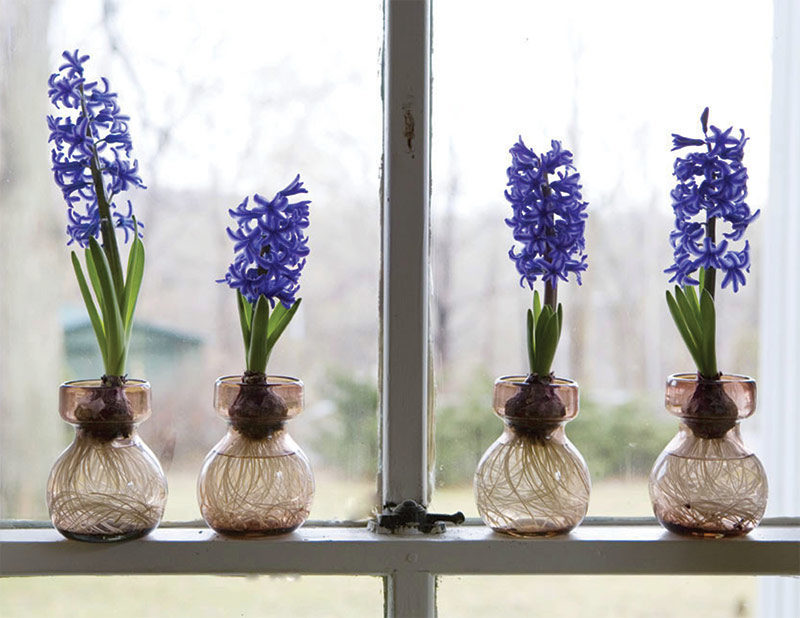SEEDS & BULBS
INDOOR BLOOMS: THE ART OF FORCING BULBS
A pot of tulips on the window sill in February can make a winter-worn gardener renew the desire to survive the winter.
At the simplest level, to force a bulb really means just that, to create an environment that pushes the bulb through its natural growth stages quicker than it would happen on its own - essentially you trick the bulb into blooming outside of its natural rhythm. Tulips, daffodils, hyacinths, crocus, scillas, and muscari can be forced into flower in late winter and early spring.
Potting
If you are planting bulbs in soil, choose a pot that is at least twice as tall, and as wide, as your bulb. Fill the pot with light potting soil and plant the bulb, pointed side facing up, just below the surface. If you are planting tulips, the flat side of the bulb should be placed next to the rim of the pot since the largest leaf will always emerge and grow on that side, producing a more desirable looking pot. You should be able to see the point of the bulb poking out of the soil slightly. If you are planting multiple bulbs in one pot (which will give you a beautiful, full display) make sure to plant the bulbs close together, but never touching one another. Water the soil well and be sure to keep it moist at all times, but never allow water to stand at the bottom of the pot. Bulbs are very susceptible to rot so you must use a container with a good drainage hole. Now that your bulbs are planted, you're not quite finished with them yet. Most bulb types are going to need a chilling period before they will flower.
Chilling Periods
Outside in the garden, a bulb requires the cold winter season in order to store enough energy to grow tall stems and flowers in the spring. If you want to grow stems and flowers inside during the winter months, you will have to simulate this cold spell with your bulbs, either by storing them in a dark, cool basement or, in some cases, even keeping them in the refrigerator for several weeks. Each type of bulb requires a different chilling period, ranging anywhere from ten weeks to no more than a day or two. A basic rule to remember is to leave your bulbs in their cooling spot until they are showing hardy signs of growth, such as roots coming out of the drainage holes in the bottom of the pot or until that fresh stem is sprouting about two inches out of the top of the bulb.
Forcing In Water
If you want to try your hand at forcing in water as opposed to soil, some bulbs will work better than others. Hyacinths, crocus, and daffodils are good choices for this. Special clear, glass vases are made specially for this use, however you can often repurpose something you already have. Whatever you choose, the bulb should be held just above the surface of the water or just touching. The vase is then kept in a cool, dark room for four to eight weeks until the root system has developed and the top elongates. At this point, it should be placed in a bright window, where the plant will bloom.

Blooming
Once the signs of growth are strong, it's time to move your plants out into the warmth and sunlight. Moving them in stages will help ensure healthier blooms. Start them off in a cooler area of your home, until they have adjusted to the warmer temperature and the brighter light. When stems take on a very healthy green colour, move them into full sunlight and watch the beauty unfold. Again, each type of bulb will take a different amount of time to bloom and last for a different length of time. As a general rule, the cooler your home, the longer the flowers will last. Once the bulbs are blooming, move the pots to a cool location each night to prolong the life of the flowers. Sadly, almost all forced bulbs will only grow once, as they have used up all of their stored energy during the forcing process. Once the flowers have died, discard your bulbs and the soil, clean the pots and put them away until next winter when you can begin the process all over again.
Timing
The best time to get bulbs for forcing is in the fall or early winter months. Any time from September until December you will find healthy bulbs at your local nursery that will work for forcing. As a loose guide, if you want your bulbs to bloom in January, normally you'll need to begin forcing in early September, if you want them to bloom in February, begin in October and so on. Remember, each type of bulb will take a different amount of time to grow, so do a bit of research specific to your variety before you begin.
Popular Bulbs By Forcing
Technically, any bulb can be forced to bloom indoors. However, there are some that are much easier than others, and much more practical to try because of their fragrance, strength, or blooming period. Here are a few more popular and relatively easy to force, along with some basic tips on how to get them to grow.
Paperwhites
One of the easiest bulbs to force indoors because these bulbs do not require much of a cooling period and will grow very quickly once they have been potted. If you buy the bulbs very early, before the end of September, you should store them in a cool dry place until you pot them, and it's recommended that you pot them before the end of October. Paper whites grow very well in water and pebbles. They are extremely fragrant.
Hyacinths
Can be forced in about eight to ten weeks and will grow in both soil and water and pebbles. Special hyacinth glasses are also available. These bulbs require a cooling period in a place with a temperature no higher than 10 C. Once roots have grown and the bulb has sprouted substantially (3 to 5 inches), move into a warm spot with direct sunlight. Hyacinths will bloom for about one week. Hyacinths may have a tendency not to have an elongated flower stem and "stick" in the clasp of leaves. This problem may be overcome by placing the plants in the dark for a few days or placing a paper cone over the plants in order to "draw" the flower out of the bulbs.
Crocus
Crocus can also be grown both in soil and in water, and you can buy crocus glasses to fit individual bulbs. They will bloom in approximately 10 weeks and flowers last for several weeks, provided you keep them in a cool place. You'll need to cool your crocus in a dark dry place until roots have filled the glass or until you see a small pale shoot about an inch high. Place in indirect sun until shoot is bright green, then expose to full sunlight.
Tulips
Everybody's favourite spring bloom can be grown indoors in the winter, but is one of the more difficult bulbs to force. Remember to always point the flat side of a tulip bulb toward the edge of the pot, as this is where the largest leaf will emerge. Tulips are prone to virus, so be sure that they have excellent drainage, and are exposed to good air circulation. Tulips require a very long chilling period - up to 16 weeks - in order to produce healthy blooms, so it's best to start forcing in early September, if you wish to have flowers by January.




